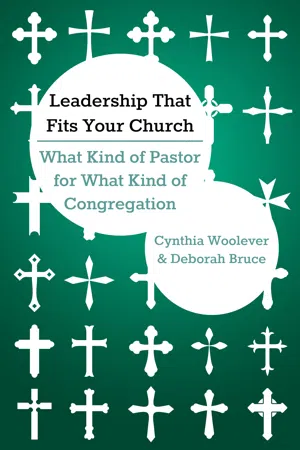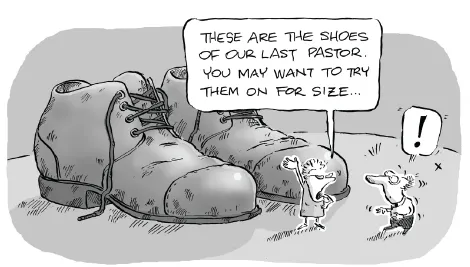![]()
Chapter 1
What Kind of Pastor for What Kind of Congregation?
Three churches face a common situation: a pastoral transition. Their efforts to find a pastor who is a good match for the congregation or to improve the pastor-church fit will illustrate each chapter’s main ideas. Their stories also underscore the high stakes for lay leaders and pastors who want only the best for their congregation’s ministries. Our first case study involves a mainline Protestant church.1
Franklin Downtown Church
After serving faithfully for 17 years, the congregation’s much-loved pastor retired. An interim pastor began helping the church prepare for a new pastor. The lay leaders formed a search committee that represented the congregation’s diversity: newcomers, young people, seniors, and parents. The search committee used an every-member survey to identify the skills and traits they wanted in their next pastor. The interim pastor challenged them to think about not only what current members wanted but also the kind of pastor the church needed in the future. The committee decided they would seriously consider calling someone who met seven of their ten most-desired pastoral traits. Using these criteria, they selected from more than 50 pastors who were interested in the call.
Chris was one of the pastors who caught their attention. After serving six years as an associate pastor in another state, he and his wife sensed that it was time to consider a move. Chris felt called to be a solo pastor and saw his associate pastor experience as good preparation. Franklin Downtown Church seemed to be a theologIcally moderate and healthy congregation that offered all that they had hoped for in a new call. Located in Chris’s home state, the church would make it possible to be closer to family, a plus given their young children. The church’s location was desirable for other reasons, too; it was in a college community with many professionals and cultural events. Finally, as a financially secure church, it offered a good salary.
As the search committee begins interviewing pastors, will they be able to hold to the skills and traits they committed to in the beginning? Or as they interview potential candidates face to face, will they be willing to modify that list if a candidate interviews well and captures their hearts? What do Chris and the committee need to know to determine if this congregation is a good fit for his leadership gifts?
Why Effective Congregational Leadership Is More Difficult than Ever
Social change over the past four decades continues to alter the landscape for pastoral ministry and congregations. Here we outline a few significant trends that influence all pastoral transitions.2
More member mobility. Between 40 and 70% of worshipers in a typical congregation grew up in or transferred their membership from a congregation in another denomination.3 People in different denominations vary in their definitions of good leadership and effective congregational ministry, so these switchers bring numerous expectations to their new congregations. Pastors lead churches whose members, having arrived from diverse faith traditions, want to go in several directions simultaneously.
Many churches encounter high turnover in the pews. One in three worshipers in the typical congregation is new—attending his or her current congregation for five years or less. In Protestant churches, the largest group of new worshipers is switchers (38%).4 Switchers are prompted to change denominations by marriage to someone of another faith, moving to a new community, changes in their values and preferences, and other reasons. Another third of new worshipers are either first-timers (9%)—people who have never regularly attended anywhere—or returnees (22%)—people who attended religious services earlier in their lives and now are returning to participation. Transfers, who make up the final third of new worshipers (31%), come from another church within the same denomination.5 They may arrive expecting their new church to be the same as—or better than—their previous church. Their conscious and unconscious expectations color their evaluation of their new church home.
Worshiper mobility and other issues contribute to diverse opinions in the congregation. Almost one in four worshipers is unaware of their congregation’s vision or think the goals or directions are unclear. Views about the congregation’s future divide worshipers: should we go back to the way we did things in the past, rethink where we are heading, or decide on new directions?6
Minority viewpoints collide with majority votes. Congregations now take democratic decision making to new heights, giving attendees multiple opportunities to participate. Almost all worshipers (94%) express satisfaction with their part in the congregation’s decisions.7 The 1960s saw the religious pluralism ideal expand beyond mere tolerance to a greater desire to respect individualism and minority opinions.8 In previous decades, a majority vote required those expressing minority viewpoints to acquiesce quietly to majority rule. Although the desire to make decisions by majority vote in churches remains, decision makers are increasingly concerned about ensuring those with minority views are happy and feel valued. As a result, the door on any decision rarely closes firmly, and debates continue. Seeking consensus in all matters makes pastoral leadership more complicated and forward movement more perilous.
Many styles of leadership. Unfortunately, many people in the pews can recount painful chapters with previous pastors and lay staff leaders who took the church in directions that damaged relationships and ministries. Some members who complain about pastoral leadership may actually feel that the leadership they have is not what they believe the church needs.
The majority of worshipers describe their pastor or priest as one who inspires people to take action.9 However, some worshipers prefer a proactive leadership style, in which the leader tends to take charge. In a few settings, a reactive style—leadership that acts on the goals that worshipers have set—prevails. Few churches operate in a pastoral leadership vacuum, in which the people in the pews initiate most activities.
In general, roughly half of worshipers feel strongly allied with the congregation’s key leader. They report that there is a very good match between their church and their minister, pastor, or priest. Another third agree that the match is a good one. Unfortunately, however, a small number of dissatisfied people, especially if they hold lay leadership positions, can disrupt the harmony of church or parish life.10
Worshipers’ satisfaction with their pastor varies from one congregation to another, in part because of the policies of the denomination or faith group. In faith groups that assign the congregation a pastor or priest—for example, Catholic parishes or Methodist churches—worshipers are less likely to view their leader as a good match.11 Even within the same congregation, the pastor and the worshipers may hold different opinions. For example, Protestant pastors are less likely to see their leadership as a good match for the congregation than typical Protestant worshipers.12
Major redefinition of the pastoral role. Luther’s early proclamations ran counter to the belief in ordained clergy as special mediators with God. As recently as 1982, a World Council of Churches document reaffirmed the widespread agreement that ministry is indeed the work of “the whole people of God.”13 Various writers document the long-standing negotiations between laity and clergy as they live out the priesthood of all believers.14 The unique role that clergy play remains ambivalent.
Several major trends push the occupation of “pastor” in diverse directions. New categories of people entering ministry in large numbers—for example, women and second-career entrants—further amplify the ambiguity surrounding the clerical role. Female pastors and pastors with prior secular career experience bring alternative leadership models to the local church. Women now serve as the senior or solo pastor in one fourth of mainline Protestant churches. More than one third of full-time pastors currently serving in local churches worked in one or more occupations before entering ministry. Among recently ordained pastors (those entering the ministry in the past ten years), the average age at ordination is 43. This compares to an average ordination age of only 26 for pastors in ministry for three or more decades.15
The debate about ministry as a profession rather than a calling or office has raged for several decades.16 Some writers argue that an increased emphasis on the professional model and credentialing led pastors away from their role as spiritual leaders. These writers believe that when pastors are evaluated on competency and acquired skills, ministry looks more like a profession in which pastors produce denominationally preferred outcomes. When leaders are encouraged to concentrate on how to make a difference in the world and be effective leaders, they have less time to be “made different” in their relationship with God.17
More small churches and fewer full-time pastors. Fewer worshipers today report attending worship services weekly. Over the course of an average month, the percentage of worshipers in attendance at all four weekend services is less than the percentage a decade ago.18 The average church now has less than 100 people attending worship services. Congregations slipping below this critical number find funding even one full-time pastoral leader taxing. This results in changes in church staffing models from an emphasis on full-time ordained clergy to a greater reliance on part-time pastors and lay staff members.19
More demands on smaller budgets. One in three congregations now reports a declining financial base.20 Yet church expenses continue to escalate. For many congregations, funding one or more staff positions includes providing salaries, housing allowances, health care benefits, and retirement plans. The costs of building maintenance, electricity, heating, and other basics further strain existing budgets—particularly for churches with aging facilities. In real dollars, many congrega...

